Human Resource Management Practices and Policies at TESCO
VerifiedAdded on 2021/01/02
|15
|4766
|342
Report
AI Summary
This report provides a comprehensive analysis of Human Resource Management (HRM) practices at TESCO, a prominent British multinational retail company. It begins with an introduction to HRM, its purpose, and functions, emphasizing its strategic role in aligning employees with company obj...
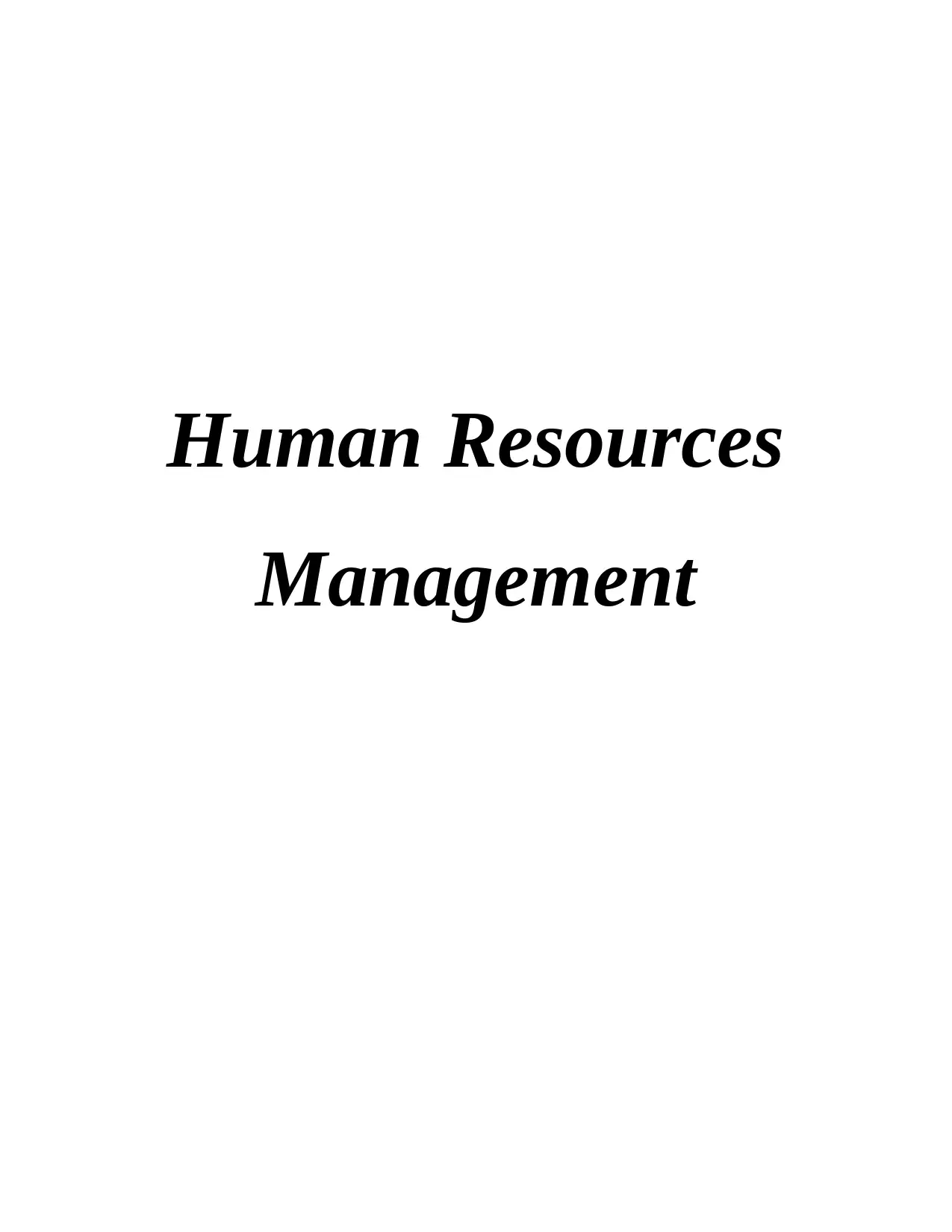
Human Resources
Management
Management
Paraphrase This Document
Need a fresh take? Get an instant paraphrase of this document with our AI Paraphraser
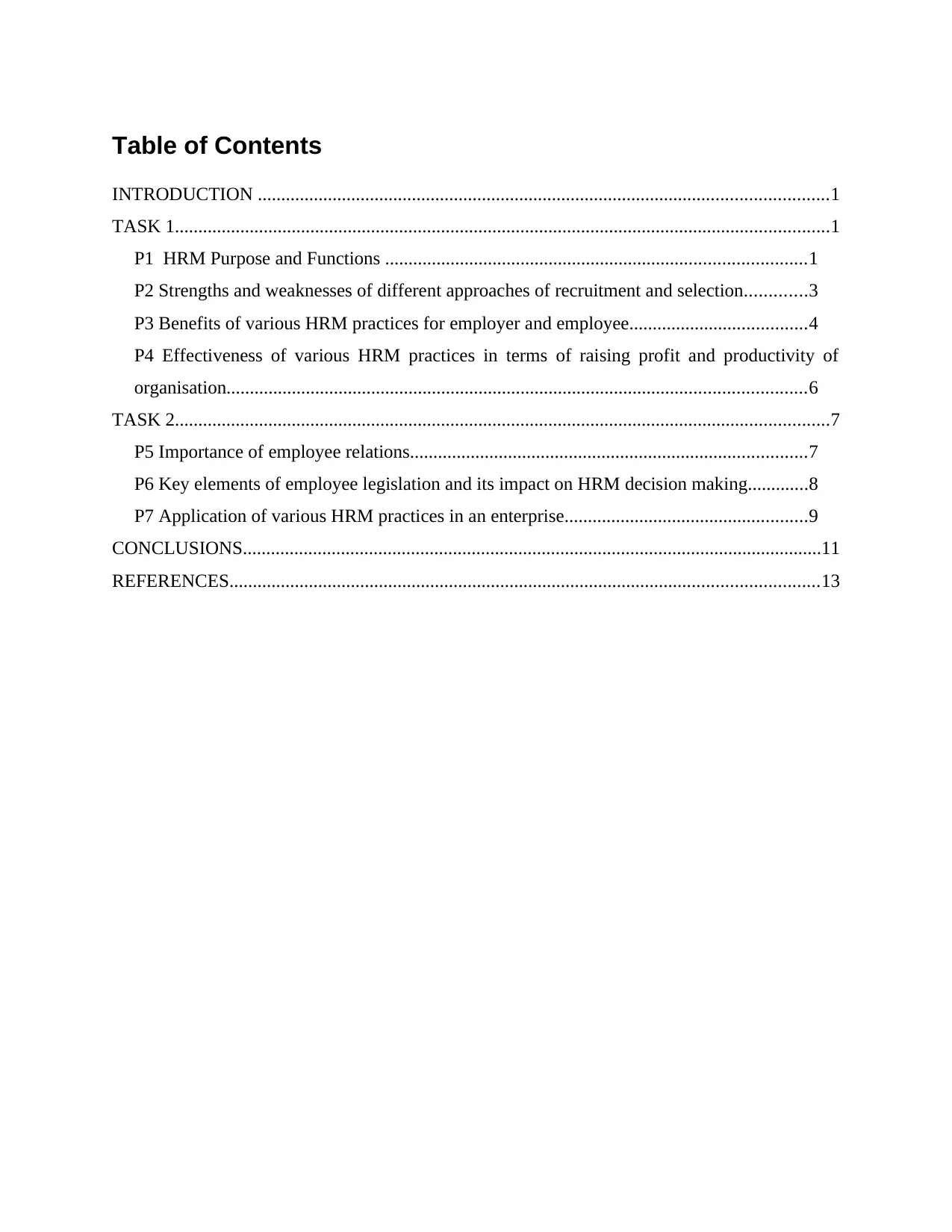
Table of Contents
INTRODUCTION ..........................................................................................................................1
TASK 1............................................................................................................................................1
P1 HRM Purpose and Functions ..........................................................................................1
P2 Strengths and weaknesses of different approaches of recruitment and selection.............3
P3 Benefits of various HRM practices for employer and employee......................................4
P4 Effectiveness of various HRM practices in terms of raising profit and productivity of
organisation............................................................................................................................6
TASK 2............................................................................................................................................7
P5 Importance of employee relations.....................................................................................7
P6 Key elements of employee legislation and its impact on HRM decision making.............8
P7 Application of various HRM practices in an enterprise....................................................9
CONCLUSIONS............................................................................................................................11
REFERENCES..............................................................................................................................13
INTRODUCTION ..........................................................................................................................1
TASK 1............................................................................................................................................1
P1 HRM Purpose and Functions ..........................................................................................1
P2 Strengths and weaknesses of different approaches of recruitment and selection.............3
P3 Benefits of various HRM practices for employer and employee......................................4
P4 Effectiveness of various HRM practices in terms of raising profit and productivity of
organisation............................................................................................................................6
TASK 2............................................................................................................................................7
P5 Importance of employee relations.....................................................................................7
P6 Key elements of employee legislation and its impact on HRM decision making.............8
P7 Application of various HRM practices in an enterprise....................................................9
CONCLUSIONS............................................................................................................................11
REFERENCES..............................................................................................................................13

INTRODUCTION
Human resource management is a function within a firm mainly concerned with hiring,
managing and controlling people that work within an organization (Human Resource
Management, 2018). It mainly comprises elements related to employee's compensation,
performance, organisation development, benefits, training and others. With span of time,
companies are subject to be adaptive and flexible to be more customer centric. In this aspect role
of HRM has become quiet critical for an organization and moved to strategic utilization of
employees and measurable effect of workforce related program over firm's operations
(Anderson, 2013). The firm taken in report is TESCO which is the third largest British
multinational firm belonging to retail and lifestyle industry. The project will explain purpose and
functions of HRM along with explaining various hiring approaches with their advantages and
disadvantages. Further discuss various HRM practices and their effectiveness, key employees
legislations and application of HRM practices will be provided.
TASK 1
P1 HRM Purpose and Functions
HRM forms the cornerstone for the success and growth of a firm. HRM is a function that
strives to achieve coordination of employees to attain company's objectives and simultaneously
maintaining its workforce satisfaction. Human resources management put employees in centre of
focus while forming any policy, program or strategy as they constitute as most valuable
resources for firm. The ideal utilisation of knowledge and experience of organisation can assist
in gaining growth and productivity in the operating market. Thus HRM works with main purpose
of maximizing output and productivity of a company by optimizing effectiveness of its
workforce (Aswathappa, 2013). Its other purpose includes:
Efficient and optimum utilization of enterprise resources i.e. human, physical and
financial.
To retain proficient employees by recognizing their efforts and rewarding them for their
good performance.
TESCO is a British multinational brand that was established in 1919 with its headquarters
in Hertfordshire, England. The firm deals in large variety of groceries and general merchandise
comprising food, home appliances, electronics, financial services, telecom, internet services and
1
Human resource management is a function within a firm mainly concerned with hiring,
managing and controlling people that work within an organization (Human Resource
Management, 2018). It mainly comprises elements related to employee's compensation,
performance, organisation development, benefits, training and others. With span of time,
companies are subject to be adaptive and flexible to be more customer centric. In this aspect role
of HRM has become quiet critical for an organization and moved to strategic utilization of
employees and measurable effect of workforce related program over firm's operations
(Anderson, 2013). The firm taken in report is TESCO which is the third largest British
multinational firm belonging to retail and lifestyle industry. The project will explain purpose and
functions of HRM along with explaining various hiring approaches with their advantages and
disadvantages. Further discuss various HRM practices and their effectiveness, key employees
legislations and application of HRM practices will be provided.
TASK 1
P1 HRM Purpose and Functions
HRM forms the cornerstone for the success and growth of a firm. HRM is a function that
strives to achieve coordination of employees to attain company's objectives and simultaneously
maintaining its workforce satisfaction. Human resources management put employees in centre of
focus while forming any policy, program or strategy as they constitute as most valuable
resources for firm. The ideal utilisation of knowledge and experience of organisation can assist
in gaining growth and productivity in the operating market. Thus HRM works with main purpose
of maximizing output and productivity of a company by optimizing effectiveness of its
workforce (Aswathappa, 2013). Its other purpose includes:
Efficient and optimum utilization of enterprise resources i.e. human, physical and
financial.
To retain proficient employees by recognizing their efforts and rewarding them for their
good performance.
TESCO is a British multinational brand that was established in 1919 with its headquarters
in Hertfordshire, England. The firm deals in large variety of groceries and general merchandise
comprising food, home appliances, electronics, financial services, telecom, internet services and
1
⊘ This is a preview!⊘
Do you want full access?
Subscribe today to unlock all pages.

Trusted by 1+ million students worldwide

so on. It forms third largest retail brand in UK and 9th largest retailer in world. Company has
around 7500 stores in approx 11 nations whose operations are handled by a proficient team of
around 480000 employees across the globe. Thus, for TESCO HRM forms backbone to hire,
manage, train, motivate and satisfy its employees. Below are some prominent HRM functions
that are undertaken by HR department of TESCO:
Recruitment and Selections: Hiring procedure forms the initial and most critical
function of HR department. TESCO being a customer centric firm pay special attention in its
hiring process wherein first it thoroughly examines job requirements, conduct screening of
prospectus candidates and then select most suitable person for particular job profile (Brewster
and Hegewisch, 2017). It is critical process as it involves HR managers of TESCO to align
firm's objectives with the career goals and aspirations of prospective candidate. Also it becomes
critcal for managers to adhere by workforce planning concept so as to be ensure that it meets all
its service and production requirements along with aims and objectives.
Training and development : It forms indispensable function of HR department of
TESCO that is concerned with inducing and enhancing Knowledge, Skill and actions in its
employees so at to increase their proficiency and productivity. This forms beneficial aspect both
in context to employees as well as for company as it motivates individual to take bigger
challenges and prepares them to undertake their future job related responsibilities. Further it also
enables firm to successfully imply workforce planning in its business process by aligning
personal objectives of employees with that of the firm goals.
2
around 7500 stores in approx 11 nations whose operations are handled by a proficient team of
around 480000 employees across the globe. Thus, for TESCO HRM forms backbone to hire,
manage, train, motivate and satisfy its employees. Below are some prominent HRM functions
that are undertaken by HR department of TESCO:
Recruitment and Selections: Hiring procedure forms the initial and most critical
function of HR department. TESCO being a customer centric firm pay special attention in its
hiring process wherein first it thoroughly examines job requirements, conduct screening of
prospectus candidates and then select most suitable person for particular job profile (Brewster
and Hegewisch, 2017). It is critical process as it involves HR managers of TESCO to align
firm's objectives with the career goals and aspirations of prospective candidate. Also it becomes
critcal for managers to adhere by workforce planning concept so as to be ensure that it meets all
its service and production requirements along with aims and objectives.
Training and development : It forms indispensable function of HR department of
TESCO that is concerned with inducing and enhancing Knowledge, Skill and actions in its
employees so at to increase their proficiency and productivity. This forms beneficial aspect both
in context to employees as well as for company as it motivates individual to take bigger
challenges and prepares them to undertake their future job related responsibilities. Further it also
enables firm to successfully imply workforce planning in its business process by aligning
personal objectives of employees with that of the firm goals.
2
Paraphrase This Document
Need a fresh take? Get an instant paraphrase of this document with our AI Paraphraser
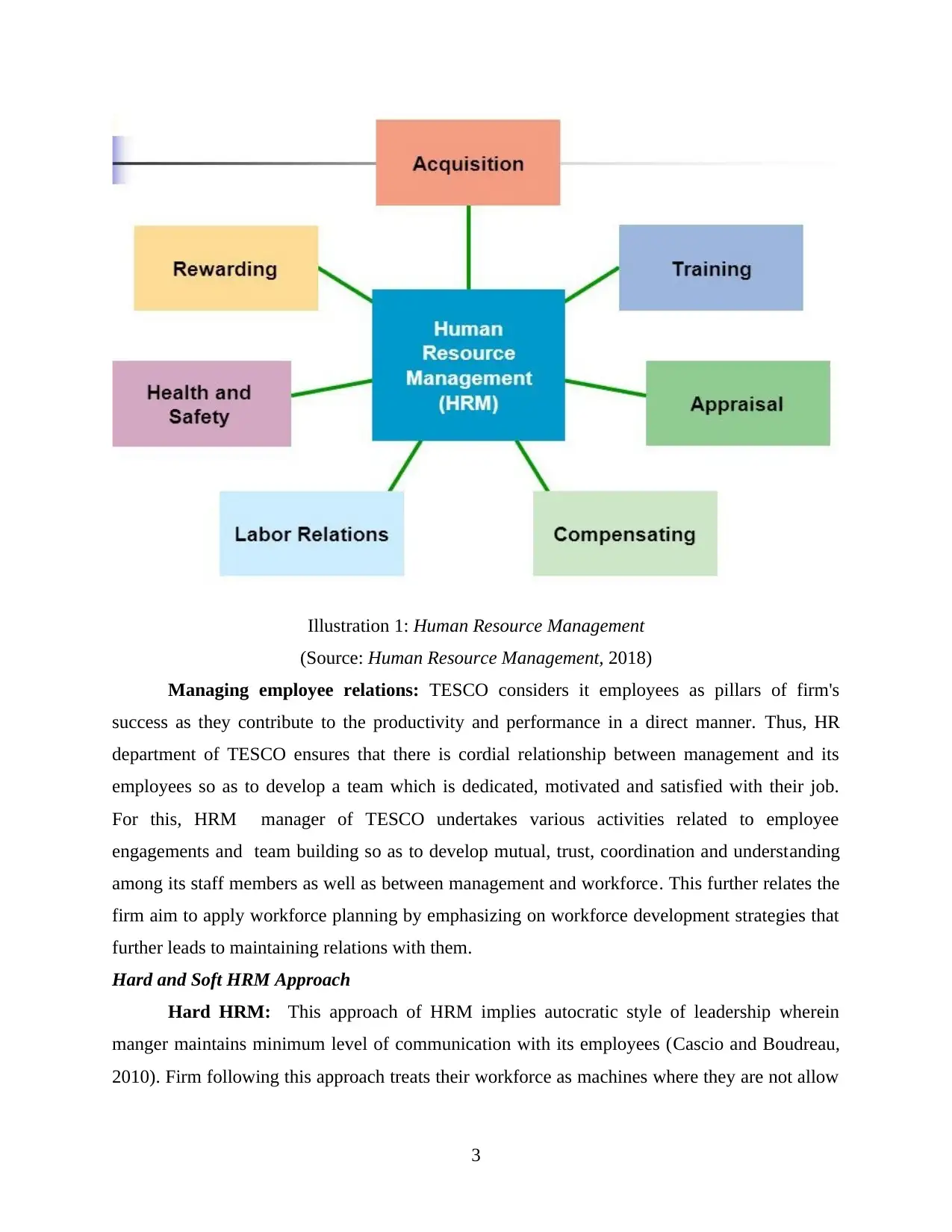
(Source: Human Resource Management, 2018)
Managing employee relations: TESCO considers it employees as pillars of firm's
success as they contribute to the productivity and performance in a direct manner. Thus, HR
department of TESCO ensures that there is cordial relationship between management and its
employees so as to develop a team which is dedicated, motivated and satisfied with their job.
For this, HRM manager of TESCO undertakes various activities related to employee
engagements and team building so as to develop mutual, trust, coordination and understanding
among its staff members as well as between management and workforce. This further relates the
firm aim to apply workforce planning by emphasizing on workforce development strategies that
further leads to maintaining relations with them.
Hard and Soft HRM Approach
Hard HRM: This approach of HRM implies autocratic style of leadership wherein
manger maintains minimum level of communication with its employees (Cascio and Boudreau,
2010). Firm following this approach treats their workforce as machines where they are not allow
3
Illustration 1: Human Resource Management
Managing employee relations: TESCO considers it employees as pillars of firm's
success as they contribute to the productivity and performance in a direct manner. Thus, HR
department of TESCO ensures that there is cordial relationship between management and its
employees so as to develop a team which is dedicated, motivated and satisfied with their job.
For this, HRM manager of TESCO undertakes various activities related to employee
engagements and team building so as to develop mutual, trust, coordination and understanding
among its staff members as well as between management and workforce. This further relates the
firm aim to apply workforce planning by emphasizing on workforce development strategies that
further leads to maintaining relations with them.
Hard and Soft HRM Approach
Hard HRM: This approach of HRM implies autocratic style of leadership wherein
manger maintains minimum level of communication with its employees (Cascio and Boudreau,
2010). Firm following this approach treats their workforce as machines where they are not allow
3
Illustration 1: Human Resource Management
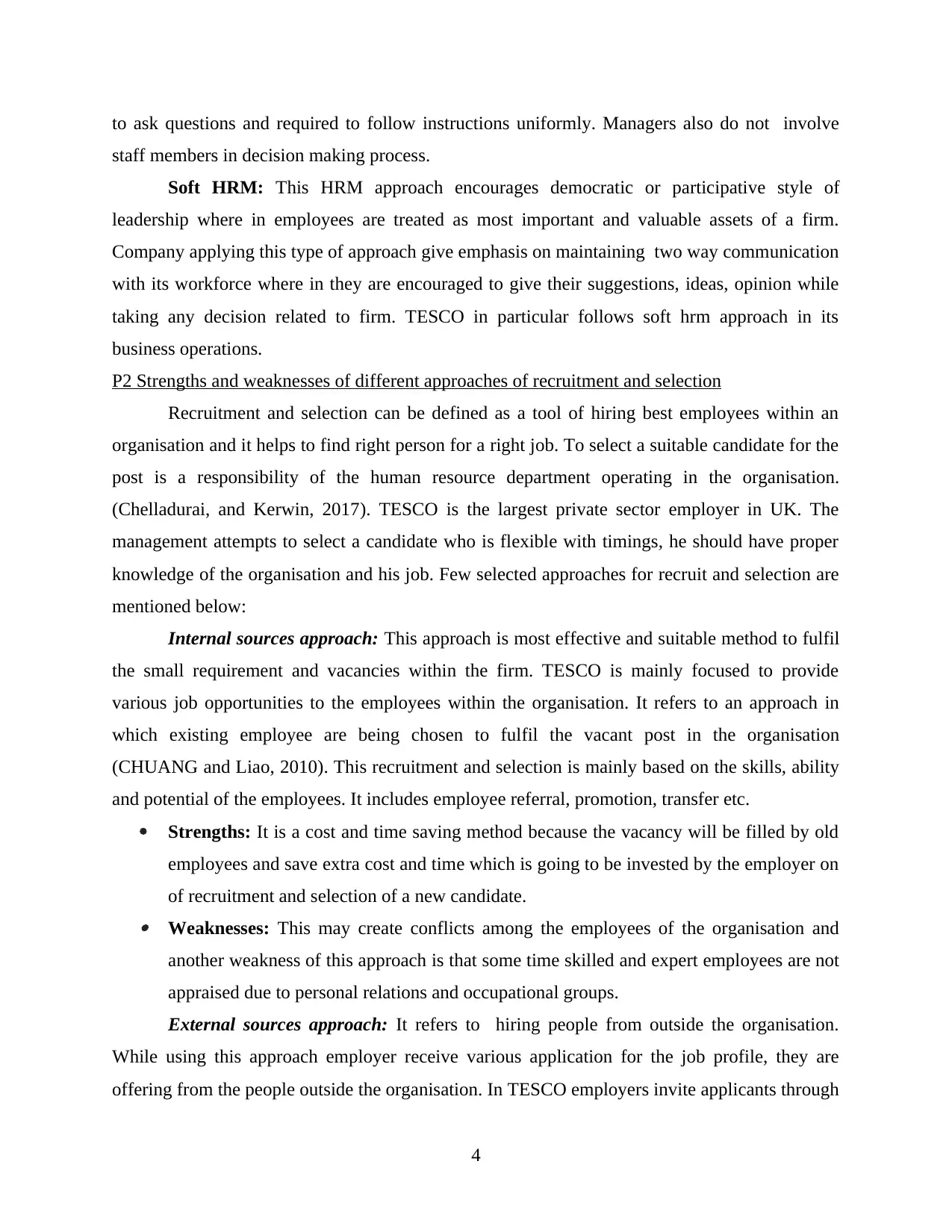
to ask questions and required to follow instructions uniformly. Managers also do not involve
staff members in decision making process.
Soft HRM: This HRM approach encourages democratic or participative style of
leadership where in employees are treated as most important and valuable assets of a firm.
Company applying this type of approach give emphasis on maintaining two way communication
with its workforce where in they are encouraged to give their suggestions, ideas, opinion while
taking any decision related to firm. TESCO in particular follows soft hrm approach in its
business operations.
P2 Strengths and weaknesses of different approaches of recruitment and selection
Recruitment and selection can be defined as a tool of hiring best employees within an
organisation and it helps to find right person for a right job. To select a suitable candidate for the
post is a responsibility of the human resource department operating in the organisation.
(Chelladurai, and Kerwin, 2017). TESCO is the largest private sector employer in UK. The
management attempts to select a candidate who is flexible with timings, he should have proper
knowledge of the organisation and his job. Few selected approaches for recruit and selection are
mentioned below:
Internal sources approach: This approach is most effective and suitable method to fulfil
the small requirement and vacancies within the firm. TESCO is mainly focused to provide
various job opportunities to the employees within the organisation. It refers to an approach in
which existing employee are being chosen to fulfil the vacant post in the organisation
(CHUANG and Liao, 2010). This recruitment and selection is mainly based on the skills, ability
and potential of the employees. It includes employee referral, promotion, transfer etc.
Strengths: It is a cost and time saving method because the vacancy will be filled by old
employees and save extra cost and time which is going to be invested by the employer on
of recruitment and selection of a new candidate. Weaknesses: This may create conflicts among the employees of the organisation and
another weakness of this approach is that some time skilled and expert employees are not
appraised due to personal relations and occupational groups.
External sources approach: It refers to hiring people from outside the organisation.
While using this approach employer receive various application for the job profile, they are
offering from the people outside the organisation. In TESCO employers invite applicants through
4
staff members in decision making process.
Soft HRM: This HRM approach encourages democratic or participative style of
leadership where in employees are treated as most important and valuable assets of a firm.
Company applying this type of approach give emphasis on maintaining two way communication
with its workforce where in they are encouraged to give their suggestions, ideas, opinion while
taking any decision related to firm. TESCO in particular follows soft hrm approach in its
business operations.
P2 Strengths and weaknesses of different approaches of recruitment and selection
Recruitment and selection can be defined as a tool of hiring best employees within an
organisation and it helps to find right person for a right job. To select a suitable candidate for the
post is a responsibility of the human resource department operating in the organisation.
(Chelladurai, and Kerwin, 2017). TESCO is the largest private sector employer in UK. The
management attempts to select a candidate who is flexible with timings, he should have proper
knowledge of the organisation and his job. Few selected approaches for recruit and selection are
mentioned below:
Internal sources approach: This approach is most effective and suitable method to fulfil
the small requirement and vacancies within the firm. TESCO is mainly focused to provide
various job opportunities to the employees within the organisation. It refers to an approach in
which existing employee are being chosen to fulfil the vacant post in the organisation
(CHUANG and Liao, 2010). This recruitment and selection is mainly based on the skills, ability
and potential of the employees. It includes employee referral, promotion, transfer etc.
Strengths: It is a cost and time saving method because the vacancy will be filled by old
employees and save extra cost and time which is going to be invested by the employer on
of recruitment and selection of a new candidate. Weaknesses: This may create conflicts among the employees of the organisation and
another weakness of this approach is that some time skilled and expert employees are not
appraised due to personal relations and occupational groups.
External sources approach: It refers to hiring people from outside the organisation.
While using this approach employer receive various application for the job profile, they are
offering from the people outside the organisation. In TESCO employers invite applicants through
4
⊘ This is a preview!⊘
Do you want full access?
Subscribe today to unlock all pages.

Trusted by 1+ million students worldwide
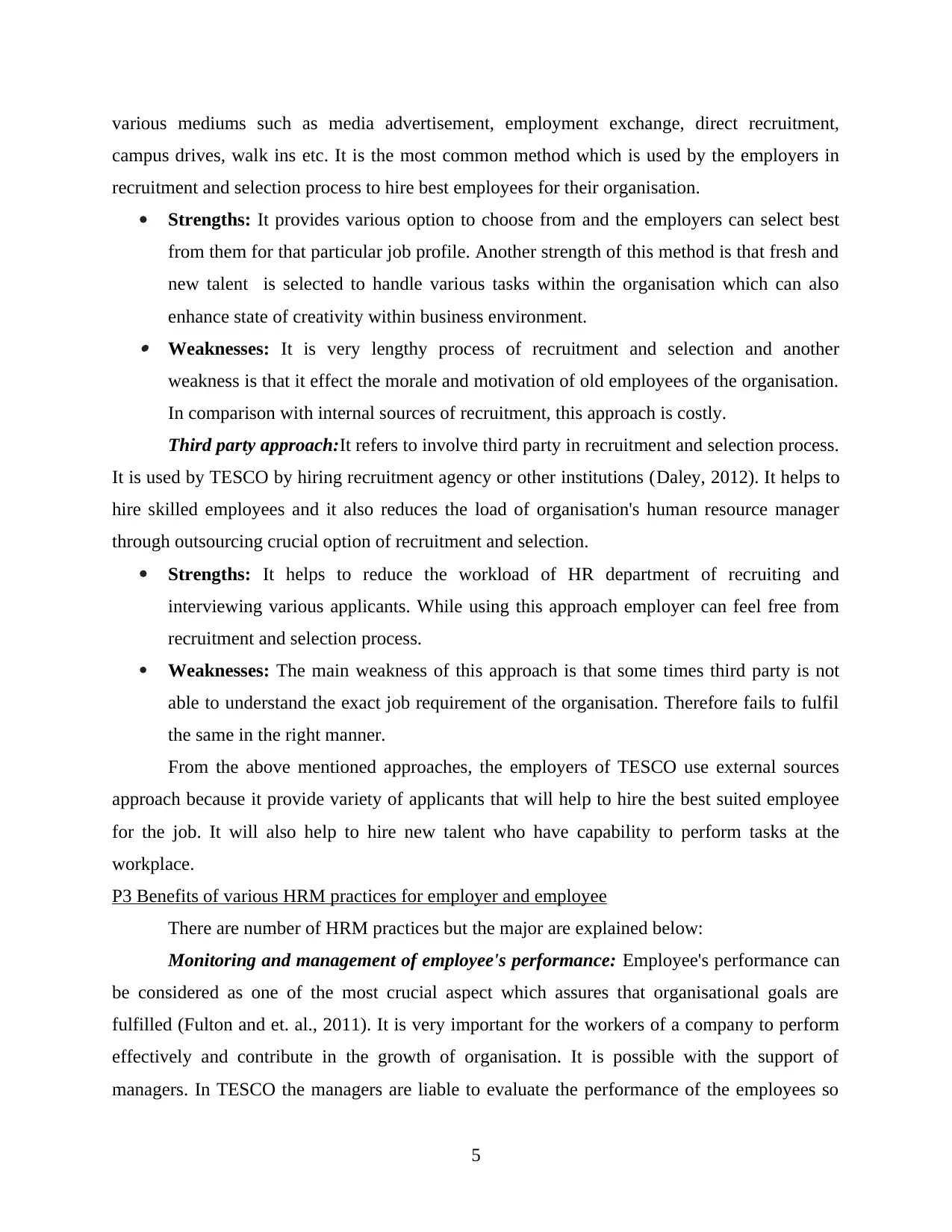
various mediums such as media advertisement, employment exchange, direct recruitment,
campus drives, walk ins etc. It is the most common method which is used by the employers in
recruitment and selection process to hire best employees for their organisation.
Strengths: It provides various option to choose from and the employers can select best
from them for that particular job profile. Another strength of this method is that fresh and
new talent is selected to handle various tasks within the organisation which can also
enhance state of creativity within business environment. Weaknesses: It is very lengthy process of recruitment and selection and another
weakness is that it effect the morale and motivation of old employees of the organisation.
In comparison with internal sources of recruitment, this approach is costly.
Third party approach:It refers to involve third party in recruitment and selection process.
It is used by TESCO by hiring recruitment agency or other institutions (Daley, 2012). It helps to
hire skilled employees and it also reduces the load of organisation's human resource manager
through outsourcing crucial option of recruitment and selection.
Strengths: It helps to reduce the workload of HR department of recruiting and
interviewing various applicants. While using this approach employer can feel free from
recruitment and selection process.
Weaknesses: The main weakness of this approach is that some times third party is not
able to understand the exact job requirement of the organisation. Therefore fails to fulfil
the same in the right manner.
From the above mentioned approaches, the employers of TESCO use external sources
approach because it provide variety of applicants that will help to hire the best suited employee
for the job. It will also help to hire new talent who have capability to perform tasks at the
workplace.
P3 Benefits of various HRM practices for employer and employee
There are number of HRM practices but the major are explained below:
Monitoring and management of employee's performance: Employee's performance can
be considered as one of the most crucial aspect which assures that organisational goals are
fulfilled (Fulton and et. al., 2011). It is very important for the workers of a company to perform
effectively and contribute in the growth of organisation. It is possible with the support of
managers. In TESCO the managers are liable to evaluate the performance of the employees so
5
campus drives, walk ins etc. It is the most common method which is used by the employers in
recruitment and selection process to hire best employees for their organisation.
Strengths: It provides various option to choose from and the employers can select best
from them for that particular job profile. Another strength of this method is that fresh and
new talent is selected to handle various tasks within the organisation which can also
enhance state of creativity within business environment. Weaknesses: It is very lengthy process of recruitment and selection and another
weakness is that it effect the morale and motivation of old employees of the organisation.
In comparison with internal sources of recruitment, this approach is costly.
Third party approach:It refers to involve third party in recruitment and selection process.
It is used by TESCO by hiring recruitment agency or other institutions (Daley, 2012). It helps to
hire skilled employees and it also reduces the load of organisation's human resource manager
through outsourcing crucial option of recruitment and selection.
Strengths: It helps to reduce the workload of HR department of recruiting and
interviewing various applicants. While using this approach employer can feel free from
recruitment and selection process.
Weaknesses: The main weakness of this approach is that some times third party is not
able to understand the exact job requirement of the organisation. Therefore fails to fulfil
the same in the right manner.
From the above mentioned approaches, the employers of TESCO use external sources
approach because it provide variety of applicants that will help to hire the best suited employee
for the job. It will also help to hire new talent who have capability to perform tasks at the
workplace.
P3 Benefits of various HRM practices for employer and employee
There are number of HRM practices but the major are explained below:
Monitoring and management of employee's performance: Employee's performance can
be considered as one of the most crucial aspect which assures that organisational goals are
fulfilled (Fulton and et. al., 2011). It is very important for the workers of a company to perform
effectively and contribute in the growth of organisation. It is possible with the support of
managers. In TESCO the managers are liable to evaluate the performance of the employees so
5
Paraphrase This Document
Need a fresh take? Get an instant paraphrase of this document with our AI Paraphraser
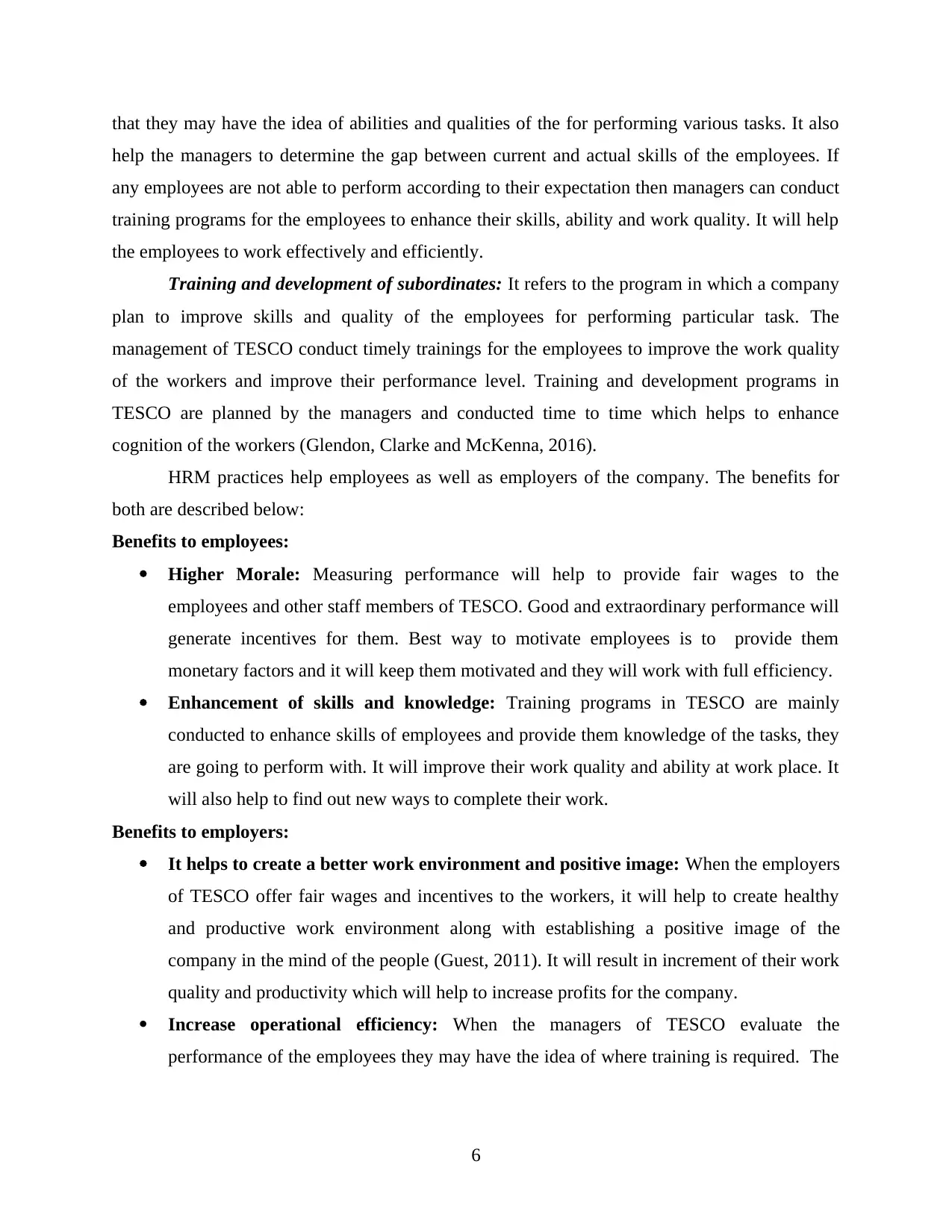
that they may have the idea of abilities and qualities of the for performing various tasks. It also
help the managers to determine the gap between current and actual skills of the employees. If
any employees are not able to perform according to their expectation then managers can conduct
training programs for the employees to enhance their skills, ability and work quality. It will help
the employees to work effectively and efficiently.
Training and development of subordinates: It refers to the program in which a company
plan to improve skills and quality of the employees for performing particular task. The
management of TESCO conduct timely trainings for the employees to improve the work quality
of the workers and improve their performance level. Training and development programs in
TESCO are planned by the managers and conducted time to time which helps to enhance
cognition of the workers (Glendon, Clarke and McKenna, 2016).
HRM practices help employees as well as employers of the company. The benefits for
both are described below:
Benefits to employees:
Higher Morale: Measuring performance will help to provide fair wages to the
employees and other staff members of TESCO. Good and extraordinary performance will
generate incentives for them. Best way to motivate employees is to provide them
monetary factors and it will keep them motivated and they will work with full efficiency.
Enhancement of skills and knowledge: Training programs in TESCO are mainly
conducted to enhance skills of employees and provide them knowledge of the tasks, they
are going to perform with. It will improve their work quality and ability at work place. It
will also help to find out new ways to complete their work.
Benefits to employers:
It helps to create a better work environment and positive image: When the employers
of TESCO offer fair wages and incentives to the workers, it will help to create healthy
and productive work environment along with establishing a positive image of the
company in the mind of the people (Guest, 2011). It will result in increment of their work
quality and productivity which will help to increase profits for the company.
Increase operational efficiency: When the managers of TESCO evaluate the
performance of the employees they may have the idea of where training is required. The
6
help the managers to determine the gap between current and actual skills of the employees. If
any employees are not able to perform according to their expectation then managers can conduct
training programs for the employees to enhance their skills, ability and work quality. It will help
the employees to work effectively and efficiently.
Training and development of subordinates: It refers to the program in which a company
plan to improve skills and quality of the employees for performing particular task. The
management of TESCO conduct timely trainings for the employees to improve the work quality
of the workers and improve their performance level. Training and development programs in
TESCO are planned by the managers and conducted time to time which helps to enhance
cognition of the workers (Glendon, Clarke and McKenna, 2016).
HRM practices help employees as well as employers of the company. The benefits for
both are described below:
Benefits to employees:
Higher Morale: Measuring performance will help to provide fair wages to the
employees and other staff members of TESCO. Good and extraordinary performance will
generate incentives for them. Best way to motivate employees is to provide them
monetary factors and it will keep them motivated and they will work with full efficiency.
Enhancement of skills and knowledge: Training programs in TESCO are mainly
conducted to enhance skills of employees and provide them knowledge of the tasks, they
are going to perform with. It will improve their work quality and ability at work place. It
will also help to find out new ways to complete their work.
Benefits to employers:
It helps to create a better work environment and positive image: When the employers
of TESCO offer fair wages and incentives to the workers, it will help to create healthy
and productive work environment along with establishing a positive image of the
company in the mind of the people (Guest, 2011). It will result in increment of their work
quality and productivity which will help to increase profits for the company.
Increase operational efficiency: When the managers of TESCO evaluate the
performance of the employees they may have the idea of where training is required. The
6
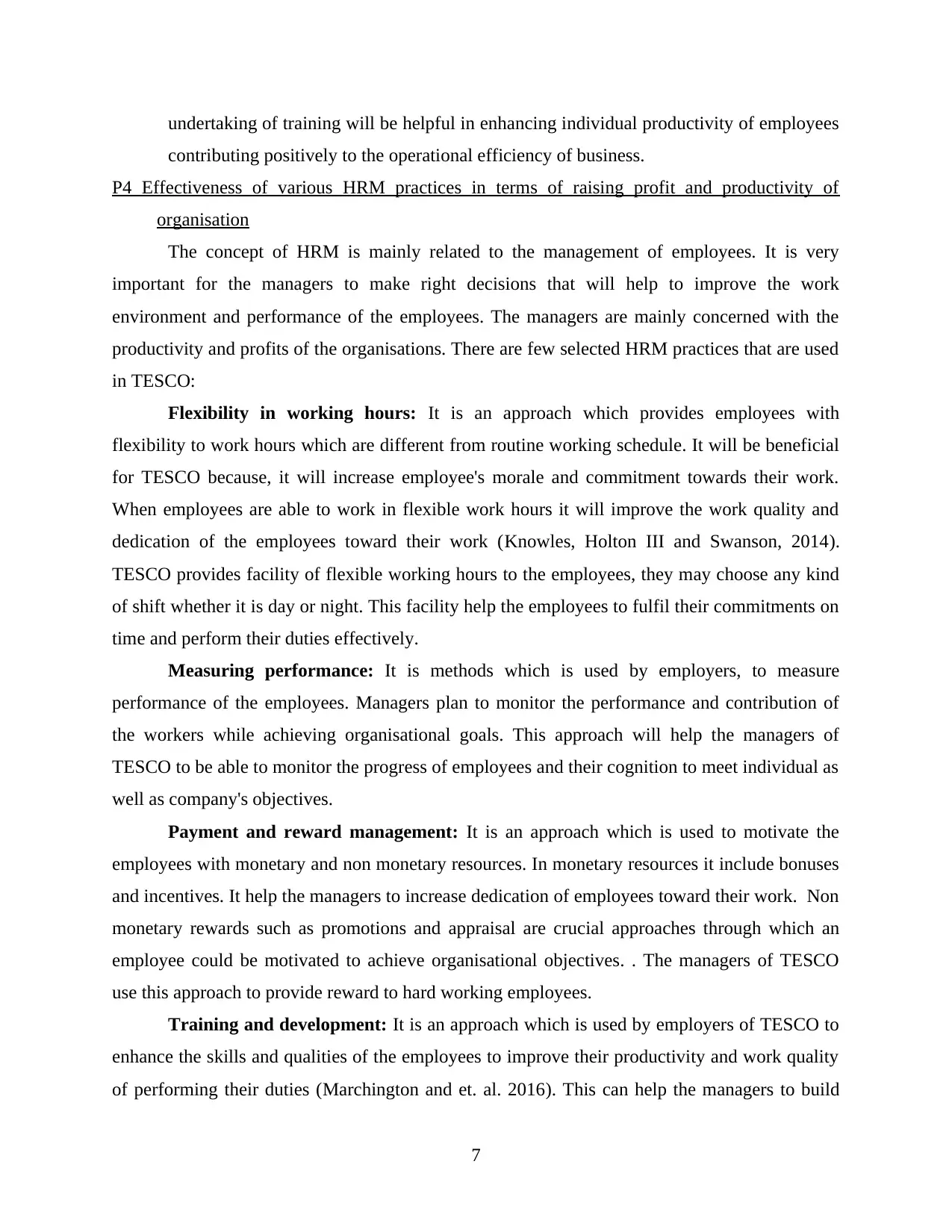
undertaking of training will be helpful in enhancing individual productivity of employees
contributing positively to the operational efficiency of business.
P4 Effectiveness of various HRM practices in terms of raising profit and productivity of
organisation
The concept of HRM is mainly related to the management of employees. It is very
important for the managers to make right decisions that will help to improve the work
environment and performance of the employees. The managers are mainly concerned with the
productivity and profits of the organisations. There are few selected HRM practices that are used
in TESCO:
Flexibility in working hours: It is an approach which provides employees with
flexibility to work hours which are different from routine working schedule. It will be beneficial
for TESCO because, it will increase employee's morale and commitment towards their work.
When employees are able to work in flexible work hours it will improve the work quality and
dedication of the employees toward their work (Knowles, Holton III and Swanson, 2014).
TESCO provides facility of flexible working hours to the employees, they may choose any kind
of shift whether it is day or night. This facility help the employees to fulfil their commitments on
time and perform their duties effectively.
Measuring performance: It is methods which is used by employers, to measure
performance of the employees. Managers plan to monitor the performance and contribution of
the workers while achieving organisational goals. This approach will help the managers of
TESCO to be able to monitor the progress of employees and their cognition to meet individual as
well as company's objectives.
Payment and reward management: It is an approach which is used to motivate the
employees with monetary and non monetary resources. In monetary resources it include bonuses
and incentives. It help the managers to increase dedication of employees toward their work. Non
monetary rewards such as promotions and appraisal are crucial approaches through which an
employee could be motivated to achieve organisational objectives. . The managers of TESCO
use this approach to provide reward to hard working employees.
Training and development: It is an approach which is used by employers of TESCO to
enhance the skills and qualities of the employees to improve their productivity and work quality
of performing their duties (Marchington and et. al. 2016). This can help the managers to build
7
contributing positively to the operational efficiency of business.
P4 Effectiveness of various HRM practices in terms of raising profit and productivity of
organisation
The concept of HRM is mainly related to the management of employees. It is very
important for the managers to make right decisions that will help to improve the work
environment and performance of the employees. The managers are mainly concerned with the
productivity and profits of the organisations. There are few selected HRM practices that are used
in TESCO:
Flexibility in working hours: It is an approach which provides employees with
flexibility to work hours which are different from routine working schedule. It will be beneficial
for TESCO because, it will increase employee's morale and commitment towards their work.
When employees are able to work in flexible work hours it will improve the work quality and
dedication of the employees toward their work (Knowles, Holton III and Swanson, 2014).
TESCO provides facility of flexible working hours to the employees, they may choose any kind
of shift whether it is day or night. This facility help the employees to fulfil their commitments on
time and perform their duties effectively.
Measuring performance: It is methods which is used by employers, to measure
performance of the employees. Managers plan to monitor the performance and contribution of
the workers while achieving organisational goals. This approach will help the managers of
TESCO to be able to monitor the progress of employees and their cognition to meet individual as
well as company's objectives.
Payment and reward management: It is an approach which is used to motivate the
employees with monetary and non monetary resources. In monetary resources it include bonuses
and incentives. It help the managers to increase dedication of employees toward their work. Non
monetary rewards such as promotions and appraisal are crucial approaches through which an
employee could be motivated to achieve organisational objectives. . The managers of TESCO
use this approach to provide reward to hard working employees.
Training and development: It is an approach which is used by employers of TESCO to
enhance the skills and qualities of the employees to improve their productivity and work quality
of performing their duties (Marchington and et. al. 2016). This can help the managers to build
7
⊘ This is a preview!⊘
Do you want full access?
Subscribe today to unlock all pages.

Trusted by 1+ million students worldwide
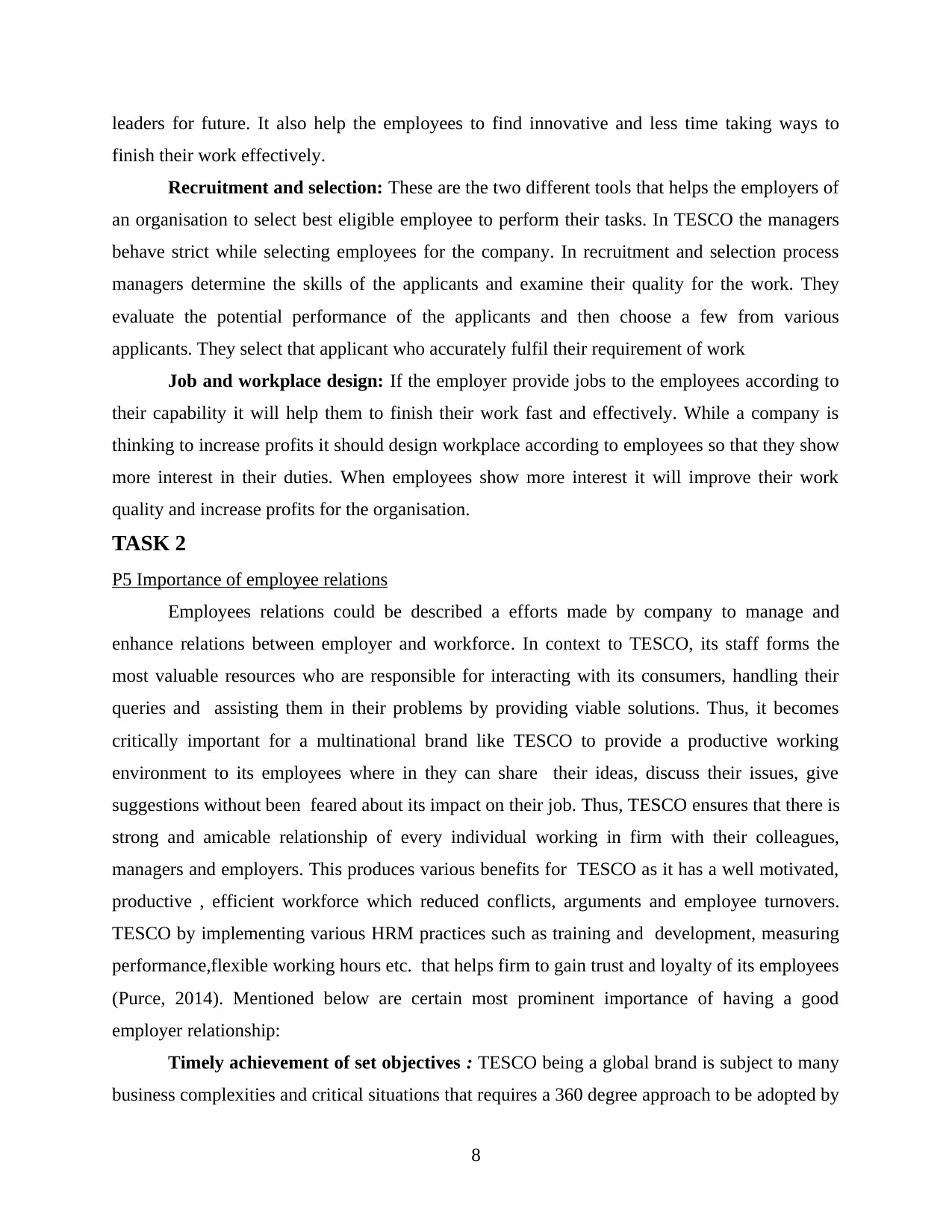
leaders for future. It also help the employees to find innovative and less time taking ways to
finish their work effectively.
Recruitment and selection: These are the two different tools that helps the employers of
an organisation to select best eligible employee to perform their tasks. In TESCO the managers
behave strict while selecting employees for the company. In recruitment and selection process
managers determine the skills of the applicants and examine their quality for the work. They
evaluate the potential performance of the applicants and then choose a few from various
applicants. They select that applicant who accurately fulfil their requirement of work
Job and workplace design: If the employer provide jobs to the employees according to
their capability it will help them to finish their work fast and effectively. While a company is
thinking to increase profits it should design workplace according to employees so that they show
more interest in their duties. When employees show more interest it will improve their work
quality and increase profits for the organisation.
TASK 2
P5 Importance of employee relations
Employees relations could be described a efforts made by company to manage and
enhance relations between employer and workforce. In context to TESCO, its staff forms the
most valuable resources who are responsible for interacting with its consumers, handling their
queries and assisting them in their problems by providing viable solutions. Thus, it becomes
critically important for a multinational brand like TESCO to provide a productive working
environment to its employees where in they can share their ideas, discuss their issues, give
suggestions without been feared about its impact on their job. Thus, TESCO ensures that there is
strong and amicable relationship of every individual working in firm with their colleagues,
managers and employers. This produces various benefits for TESCO as it has a well motivated,
productive , efficient workforce which reduced conflicts, arguments and employee turnovers.
TESCO by implementing various HRM practices such as training and development, measuring
performance,flexible working hours etc. that helps firm to gain trust and loyalty of its employees
(Purce, 2014). Mentioned below are certain most prominent importance of having a good
employer relationship:
Timely achievement of set objectives : TESCO being a global brand is subject to many
business complexities and critical situations that requires a 360 degree approach to be adopted by
8
finish their work effectively.
Recruitment and selection: These are the two different tools that helps the employers of
an organisation to select best eligible employee to perform their tasks. In TESCO the managers
behave strict while selecting employees for the company. In recruitment and selection process
managers determine the skills of the applicants and examine their quality for the work. They
evaluate the potential performance of the applicants and then choose a few from various
applicants. They select that applicant who accurately fulfil their requirement of work
Job and workplace design: If the employer provide jobs to the employees according to
their capability it will help them to finish their work fast and effectively. While a company is
thinking to increase profits it should design workplace according to employees so that they show
more interest in their duties. When employees show more interest it will improve their work
quality and increase profits for the organisation.
TASK 2
P5 Importance of employee relations
Employees relations could be described a efforts made by company to manage and
enhance relations between employer and workforce. In context to TESCO, its staff forms the
most valuable resources who are responsible for interacting with its consumers, handling their
queries and assisting them in their problems by providing viable solutions. Thus, it becomes
critically important for a multinational brand like TESCO to provide a productive working
environment to its employees where in they can share their ideas, discuss their issues, give
suggestions without been feared about its impact on their job. Thus, TESCO ensures that there is
strong and amicable relationship of every individual working in firm with their colleagues,
managers and employers. This produces various benefits for TESCO as it has a well motivated,
productive , efficient workforce which reduced conflicts, arguments and employee turnovers.
TESCO by implementing various HRM practices such as training and development, measuring
performance,flexible working hours etc. that helps firm to gain trust and loyalty of its employees
(Purce, 2014). Mentioned below are certain most prominent importance of having a good
employer relationship:
Timely achievement of set objectives : TESCO being a global brand is subject to many
business complexities and critical situations that requires a 360 degree approach to be adopted by
8
Paraphrase This Document
Need a fresh take? Get an instant paraphrase of this document with our AI Paraphraser
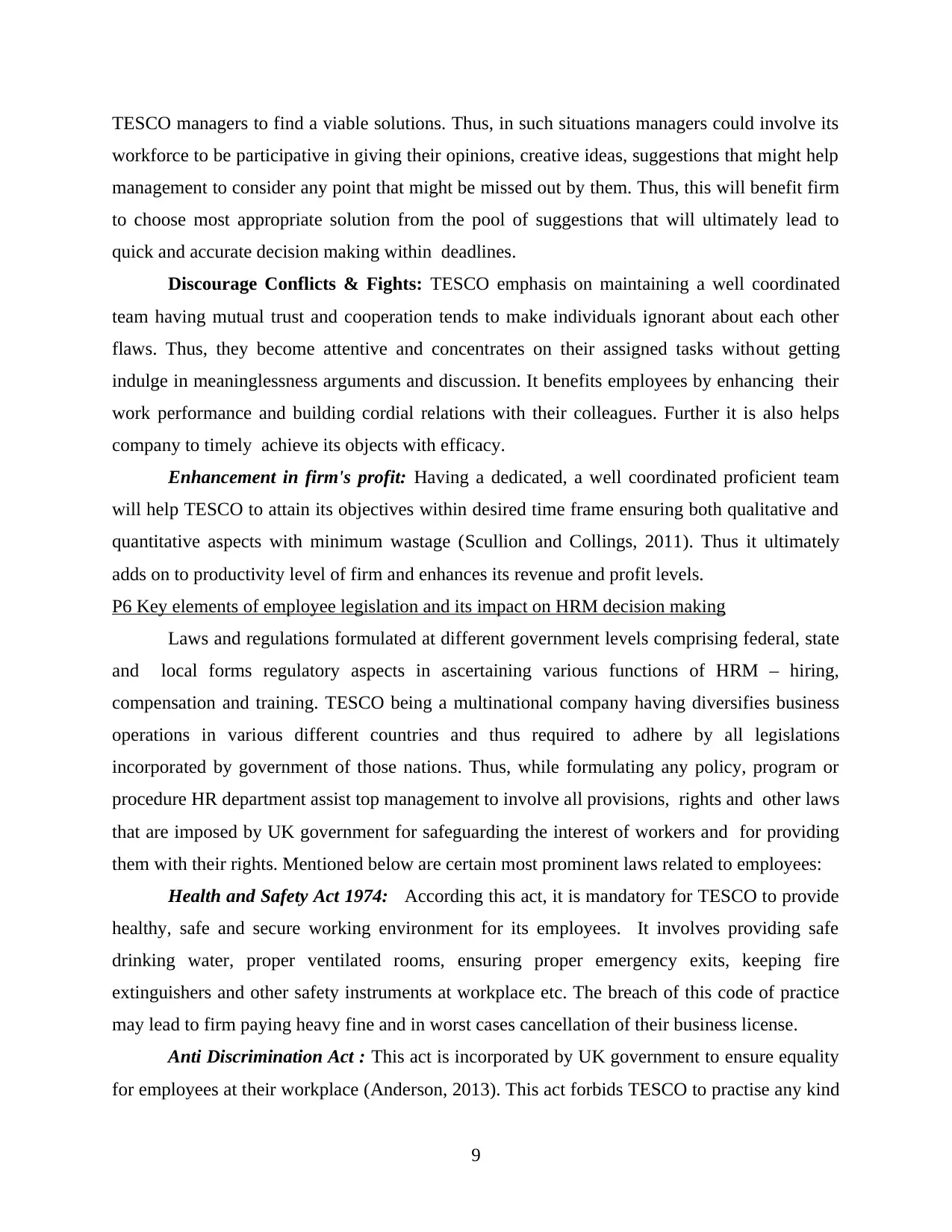
TESCO managers to find a viable solutions. Thus, in such situations managers could involve its
workforce to be participative in giving their opinions, creative ideas, suggestions that might help
management to consider any point that might be missed out by them. Thus, this will benefit firm
to choose most appropriate solution from the pool of suggestions that will ultimately lead to
quick and accurate decision making within deadlines.
Discourage Conflicts & Fights: TESCO emphasis on maintaining a well coordinated
team having mutual trust and cooperation tends to make individuals ignorant about each other
flaws. Thus, they become attentive and concentrates on their assigned tasks without getting
indulge in meaninglessness arguments and discussion. It benefits employees by enhancing their
work performance and building cordial relations with their colleagues. Further it is also helps
company to timely achieve its objects with efficacy.
Enhancement in firm's profit: Having a dedicated, a well coordinated proficient team
will help TESCO to attain its objectives within desired time frame ensuring both qualitative and
quantitative aspects with minimum wastage (Scullion and Collings, 2011). Thus it ultimately
adds on to productivity level of firm and enhances its revenue and profit levels.
P6 Key elements of employee legislation and its impact on HRM decision making
Laws and regulations formulated at different government levels comprising federal, state
and local forms regulatory aspects in ascertaining various functions of HRM – hiring,
compensation and training. TESCO being a multinational company having diversifies business
operations in various different countries and thus required to adhere by all legislations
incorporated by government of those nations. Thus, while formulating any policy, program or
procedure HR department assist top management to involve all provisions, rights and other laws
that are imposed by UK government for safeguarding the interest of workers and for providing
them with their rights. Mentioned below are certain most prominent laws related to employees:
Health and Safety Act 1974: According this act, it is mandatory for TESCO to provide
healthy, safe and secure working environment for its employees. It involves providing safe
drinking water, proper ventilated rooms, ensuring proper emergency exits, keeping fire
extinguishers and other safety instruments at workplace etc. The breach of this code of practice
may lead to firm paying heavy fine and in worst cases cancellation of their business license.
Anti Discrimination Act : This act is incorporated by UK government to ensure equality
for employees at their workplace (Anderson, 2013). This act forbids TESCO to practise any kind
9
workforce to be participative in giving their opinions, creative ideas, suggestions that might help
management to consider any point that might be missed out by them. Thus, this will benefit firm
to choose most appropriate solution from the pool of suggestions that will ultimately lead to
quick and accurate decision making within deadlines.
Discourage Conflicts & Fights: TESCO emphasis on maintaining a well coordinated
team having mutual trust and cooperation tends to make individuals ignorant about each other
flaws. Thus, they become attentive and concentrates on their assigned tasks without getting
indulge in meaninglessness arguments and discussion. It benefits employees by enhancing their
work performance and building cordial relations with their colleagues. Further it is also helps
company to timely achieve its objects with efficacy.
Enhancement in firm's profit: Having a dedicated, a well coordinated proficient team
will help TESCO to attain its objectives within desired time frame ensuring both qualitative and
quantitative aspects with minimum wastage (Scullion and Collings, 2011). Thus it ultimately
adds on to productivity level of firm and enhances its revenue and profit levels.
P6 Key elements of employee legislation and its impact on HRM decision making
Laws and regulations formulated at different government levels comprising federal, state
and local forms regulatory aspects in ascertaining various functions of HRM – hiring,
compensation and training. TESCO being a multinational company having diversifies business
operations in various different countries and thus required to adhere by all legislations
incorporated by government of those nations. Thus, while formulating any policy, program or
procedure HR department assist top management to involve all provisions, rights and other laws
that are imposed by UK government for safeguarding the interest of workers and for providing
them with their rights. Mentioned below are certain most prominent laws related to employees:
Health and Safety Act 1974: According this act, it is mandatory for TESCO to provide
healthy, safe and secure working environment for its employees. It involves providing safe
drinking water, proper ventilated rooms, ensuring proper emergency exits, keeping fire
extinguishers and other safety instruments at workplace etc. The breach of this code of practice
may lead to firm paying heavy fine and in worst cases cancellation of their business license.
Anti Discrimination Act : This act is incorporated by UK government to ensure equality
for employees at their workplace (Anderson, 2013). This act forbids TESCO to practise any kind
9
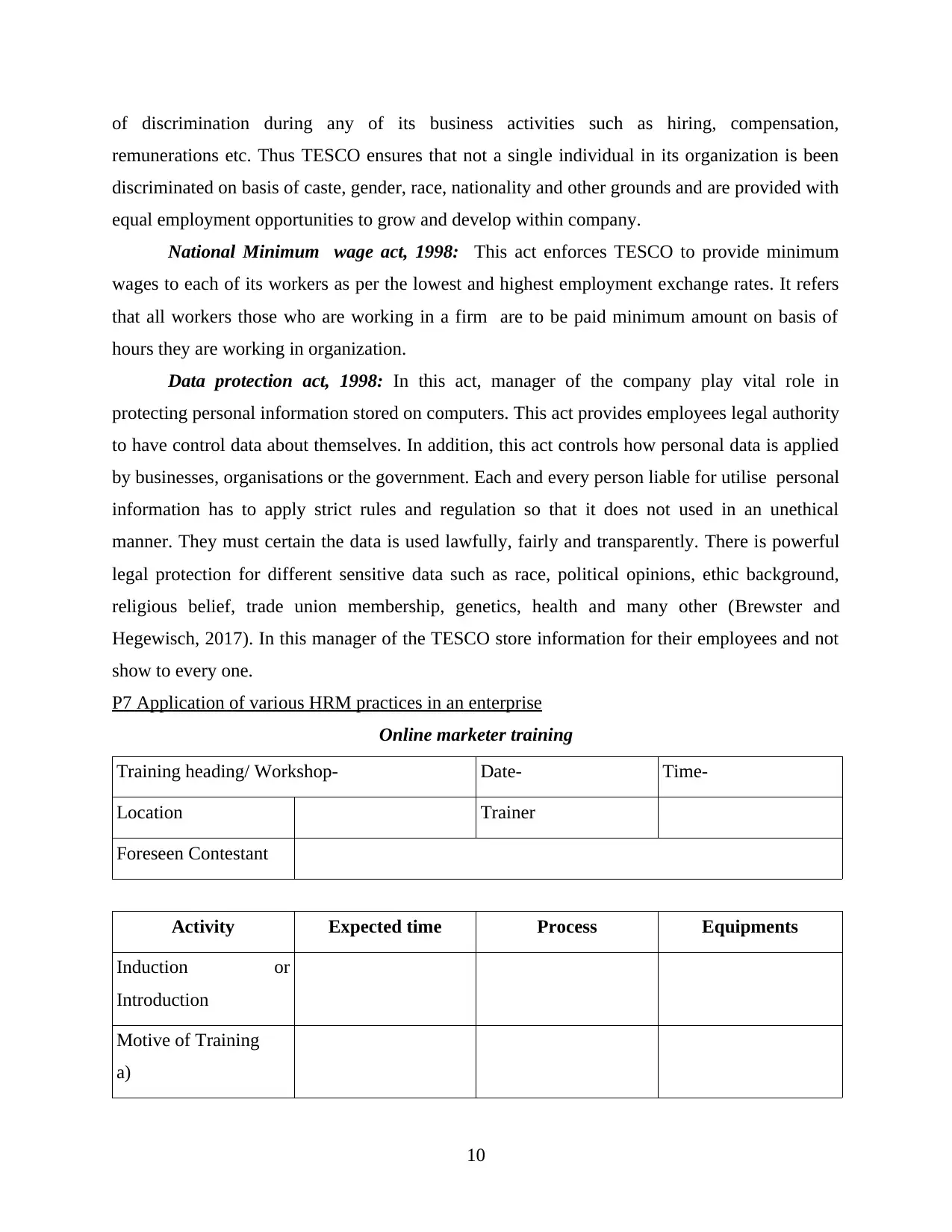
of discrimination during any of its business activities such as hiring, compensation,
remunerations etc. Thus TESCO ensures that not a single individual in its organization is been
discriminated on basis of caste, gender, race, nationality and other grounds and are provided with
equal employment opportunities to grow and develop within company.
National Minimum wage act, 1998: This act enforces TESCO to provide minimum
wages to each of its workers as per the lowest and highest employment exchange rates. It refers
that all workers those who are working in a firm are to be paid minimum amount on basis of
hours they are working in organization.
Data protection act, 1998: In this act, manager of the company play vital role in
protecting personal information stored on computers. This act provides employees legal authority
to have control data about themselves. In addition, this act controls how personal data is applied
by businesses, organisations or the government. Each and every person liable for utilise personal
information has to apply strict rules and regulation so that it does not used in an unethical
manner. They must certain the data is used lawfully, fairly and transparently. There is powerful
legal protection for different sensitive data such as race, political opinions, ethic background,
religious belief, trade union membership, genetics, health and many other (Brewster and
Hegewisch, 2017). In this manager of the TESCO store information for their employees and not
show to every one.
P7 Application of various HRM practices in an enterprise
Online marketer training
Training heading/ Workshop- Date- Time-
Location Trainer
Foreseen Contestant
Activity Expected time Process Equipments
Induction or
Introduction
Motive of Training
a)
10
remunerations etc. Thus TESCO ensures that not a single individual in its organization is been
discriminated on basis of caste, gender, race, nationality and other grounds and are provided with
equal employment opportunities to grow and develop within company.
National Minimum wage act, 1998: This act enforces TESCO to provide minimum
wages to each of its workers as per the lowest and highest employment exchange rates. It refers
that all workers those who are working in a firm are to be paid minimum amount on basis of
hours they are working in organization.
Data protection act, 1998: In this act, manager of the company play vital role in
protecting personal information stored on computers. This act provides employees legal authority
to have control data about themselves. In addition, this act controls how personal data is applied
by businesses, organisations or the government. Each and every person liable for utilise personal
information has to apply strict rules and regulation so that it does not used in an unethical
manner. They must certain the data is used lawfully, fairly and transparently. There is powerful
legal protection for different sensitive data such as race, political opinions, ethic background,
religious belief, trade union membership, genetics, health and many other (Brewster and
Hegewisch, 2017). In this manager of the TESCO store information for their employees and not
show to every one.
P7 Application of various HRM practices in an enterprise
Online marketer training
Training heading/ Workshop- Date- Time-
Location Trainer
Foreseen Contestant
Activity Expected time Process Equipments
Induction or
Introduction
Motive of Training
a)
10
⊘ This is a preview!⊘
Do you want full access?
Subscribe today to unlock all pages.

Trusted by 1+ million students worldwide

b)
Warm up
Essential Content
Required elements
Job specification
Qualification Master's Degree in marketing field from any
acknowledged University.
Adequate internship in marketing field.
Experience Should have 2 year experience of working in
marketing or sales field.
Area of expertise Should have adequate information about all
marketing tools and techniques.
Other qualities Able to handle different tasks and should
perform effectively.
Awareness about current marketing trends of
market.
Interview Questions
What are your strengths?
What are your weakness?
What grades did you get in your projects when you were in college?
What were your duties and responsibilities in your previous jobs?
Why do you want to work with us? Why should we hire you?
Person specification
Particulars Necessary criteria Desired criteria
education and training MBA In marketing Training or internships related
11
Warm up
Essential Content
Required elements
Job specification
Qualification Master's Degree in marketing field from any
acknowledged University.
Adequate internship in marketing field.
Experience Should have 2 year experience of working in
marketing or sales field.
Area of expertise Should have adequate information about all
marketing tools and techniques.
Other qualities Able to handle different tasks and should
perform effectively.
Awareness about current marketing trends of
market.
Interview Questions
What are your strengths?
What are your weakness?
What grades did you get in your projects when you were in college?
What were your duties and responsibilities in your previous jobs?
Why do you want to work with us? Why should we hire you?
Person specification
Particulars Necessary criteria Desired criteria
education and training MBA In marketing Training or internships related
11
Paraphrase This Document
Need a fresh take? Get an instant paraphrase of this document with our AI Paraphraser
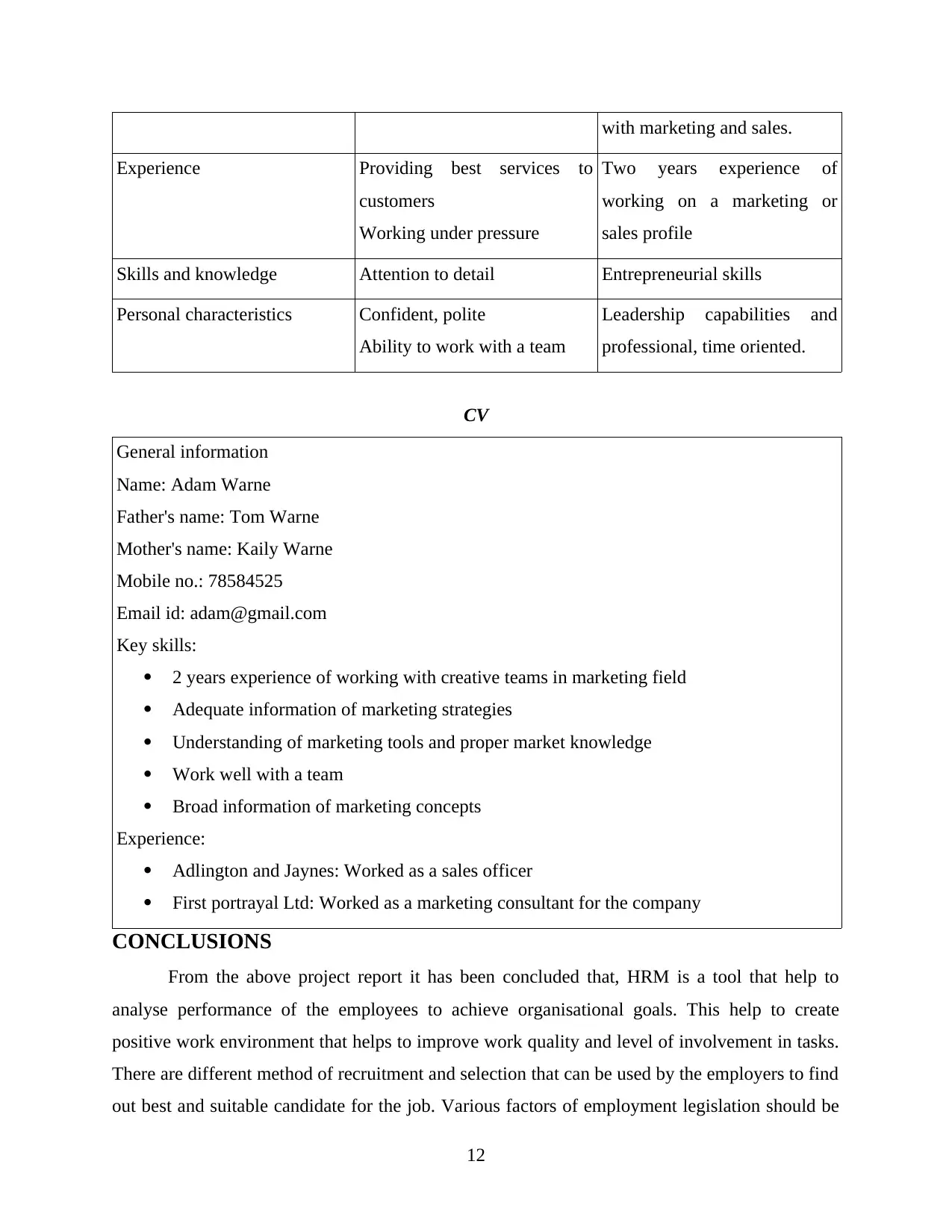
with marketing and sales.
Experience Providing best services to
customers
Working under pressure
Two years experience of
working on a marketing or
sales profile
Skills and knowledge Attention to detail Entrepreneurial skills
Personal characteristics Confident, polite
Ability to work with a team
Leadership capabilities and
professional, time oriented.
CV
General information
Name: Adam Warne
Father's name: Tom Warne
Mother's name: Kaily Warne
Mobile no.: 78584525
Email id: adam@gmail.com
Key skills:
2 years experience of working with creative teams in marketing field
Adequate information of marketing strategies
Understanding of marketing tools and proper market knowledge
Work well with a team
Broad information of marketing concepts
Experience:
Adlington and Jaynes: Worked as a sales officer
First portrayal Ltd: Worked as a marketing consultant for the company
CONCLUSIONS
From the above project report it has been concluded that, HRM is a tool that help to
analyse performance of the employees to achieve organisational goals. This help to create
positive work environment that helps to improve work quality and level of involvement in tasks.
There are different method of recruitment and selection that can be used by the employers to find
out best and suitable candidate for the job. Various factors of employment legislation should be
12
Experience Providing best services to
customers
Working under pressure
Two years experience of
working on a marketing or
sales profile
Skills and knowledge Attention to detail Entrepreneurial skills
Personal characteristics Confident, polite
Ability to work with a team
Leadership capabilities and
professional, time oriented.
CV
General information
Name: Adam Warne
Father's name: Tom Warne
Mother's name: Kaily Warne
Mobile no.: 78584525
Email id: adam@gmail.com
Key skills:
2 years experience of working with creative teams in marketing field
Adequate information of marketing strategies
Understanding of marketing tools and proper market knowledge
Work well with a team
Broad information of marketing concepts
Experience:
Adlington and Jaynes: Worked as a sales officer
First portrayal Ltd: Worked as a marketing consultant for the company
CONCLUSIONS
From the above project report it has been concluded that, HRM is a tool that help to
analyse performance of the employees to achieve organisational goals. This help to create
positive work environment that helps to improve work quality and level of involvement in tasks.
There are different method of recruitment and selection that can be used by the employers to find
out best and suitable candidate for the job. Various factors of employment legislation should be
12
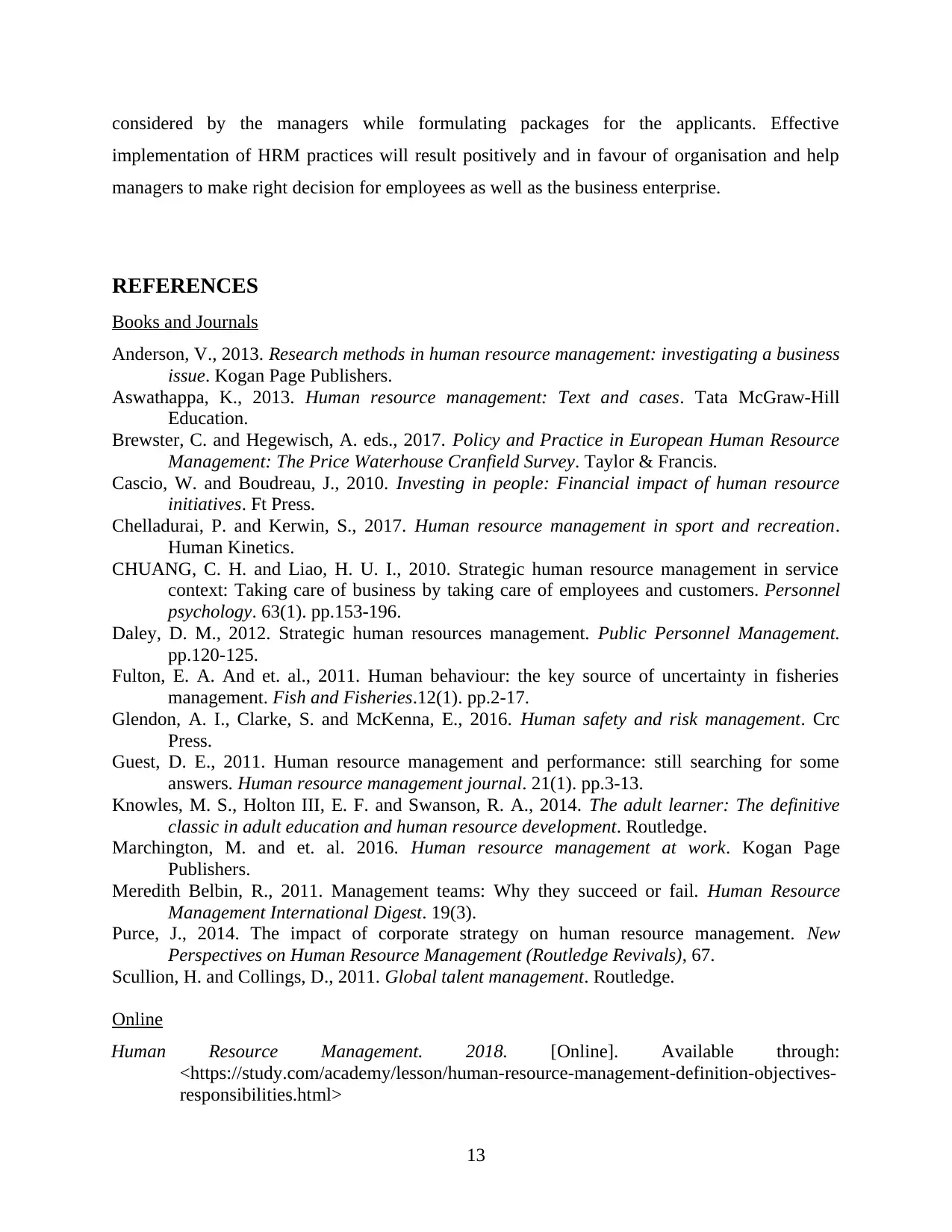
considered by the managers while formulating packages for the applicants. Effective
implementation of HRM practices will result positively and in favour of organisation and help
managers to make right decision for employees as well as the business enterprise.
REFERENCES
Books and Journals
Anderson, V., 2013. Research methods in human resource management: investigating a business
issue. Kogan Page Publishers.
Aswathappa, K., 2013. Human resource management: Text and cases. Tata McGraw-Hill
Education.
Brewster, C. and Hegewisch, A. eds., 2017. Policy and Practice in European Human Resource
Management: The Price Waterhouse Cranfield Survey. Taylor & Francis.
Cascio, W. and Boudreau, J., 2010. Investing in people: Financial impact of human resource
initiatives. Ft Press.
Chelladurai, P. and Kerwin, S., 2017. Human resource management in sport and recreation.
Human Kinetics.
CHUANG, C. H. and Liao, H. U. I., 2010. Strategic human resource management in service
context: Taking care of business by taking care of employees and customers. Personnel
psychology. 63(1). pp.153-196.
Daley, D. M., 2012. Strategic human resources management. Public Personnel Management.
pp.120-125.
Fulton, E. A. And et. al., 2011. Human behaviour: the key source of uncertainty in fisheries
management. Fish and Fisheries.12(1). pp.2-17.
Glendon, A. I., Clarke, S. and McKenna, E., 2016. Human safety and risk management. Crc
Press.
Guest, D. E., 2011. Human resource management and performance: still searching for some
answers. Human resource management journal. 21(1). pp.3-13.
Knowles, M. S., Holton III, E. F. and Swanson, R. A., 2014. The adult learner: The definitive
classic in adult education and human resource development. Routledge.
Marchington, M. and et. al. 2016. Human resource management at work. Kogan Page
Publishers.
Meredith Belbin, R., 2011. Management teams: Why they succeed or fail. Human Resource
Management International Digest. 19(3).
Purce, J., 2014. The impact of corporate strategy on human resource management. New
Perspectives on Human Resource Management (Routledge Revivals), 67.
Scullion, H. and Collings, D., 2011. Global talent management. Routledge.
Online
Human Resource Management. 2018. [Online]. Available through:
<https://study.com/academy/lesson/human-resource-management-definition-objectives-
responsibilities.html>
13
implementation of HRM practices will result positively and in favour of organisation and help
managers to make right decision for employees as well as the business enterprise.
REFERENCES
Books and Journals
Anderson, V., 2013. Research methods in human resource management: investigating a business
issue. Kogan Page Publishers.
Aswathappa, K., 2013. Human resource management: Text and cases. Tata McGraw-Hill
Education.
Brewster, C. and Hegewisch, A. eds., 2017. Policy and Practice in European Human Resource
Management: The Price Waterhouse Cranfield Survey. Taylor & Francis.
Cascio, W. and Boudreau, J., 2010. Investing in people: Financial impact of human resource
initiatives. Ft Press.
Chelladurai, P. and Kerwin, S., 2017. Human resource management in sport and recreation.
Human Kinetics.
CHUANG, C. H. and Liao, H. U. I., 2010. Strategic human resource management in service
context: Taking care of business by taking care of employees and customers. Personnel
psychology. 63(1). pp.153-196.
Daley, D. M., 2012. Strategic human resources management. Public Personnel Management.
pp.120-125.
Fulton, E. A. And et. al., 2011. Human behaviour: the key source of uncertainty in fisheries
management. Fish and Fisheries.12(1). pp.2-17.
Glendon, A. I., Clarke, S. and McKenna, E., 2016. Human safety and risk management. Crc
Press.
Guest, D. E., 2011. Human resource management and performance: still searching for some
answers. Human resource management journal. 21(1). pp.3-13.
Knowles, M. S., Holton III, E. F. and Swanson, R. A., 2014. The adult learner: The definitive
classic in adult education and human resource development. Routledge.
Marchington, M. and et. al. 2016. Human resource management at work. Kogan Page
Publishers.
Meredith Belbin, R., 2011. Management teams: Why they succeed or fail. Human Resource
Management International Digest. 19(3).
Purce, J., 2014. The impact of corporate strategy on human resource management. New
Perspectives on Human Resource Management (Routledge Revivals), 67.
Scullion, H. and Collings, D., 2011. Global talent management. Routledge.
Online
Human Resource Management. 2018. [Online]. Available through:
<https://study.com/academy/lesson/human-resource-management-definition-objectives-
responsibilities.html>
13
⊘ This is a preview!⊘
Do you want full access?
Subscribe today to unlock all pages.

Trusted by 1+ million students worldwide
1 out of 15
Related Documents
Your All-in-One AI-Powered Toolkit for Academic Success.
+13062052269
info@desklib.com
Available 24*7 on WhatsApp / Email
![[object Object]](/_next/static/media/star-bottom.7253800d.svg)
Unlock your academic potential
© 2024 | Zucol Services PVT LTD | All rights reserved.





